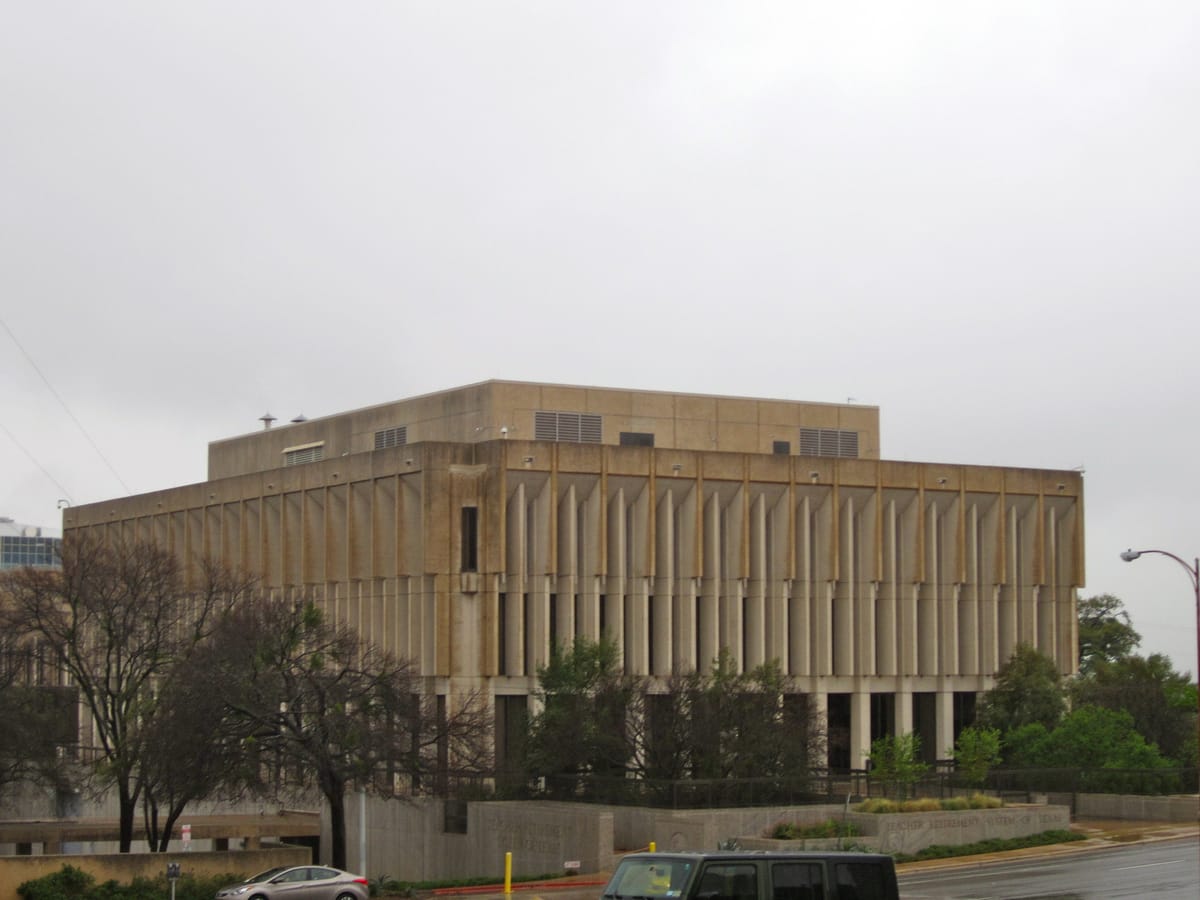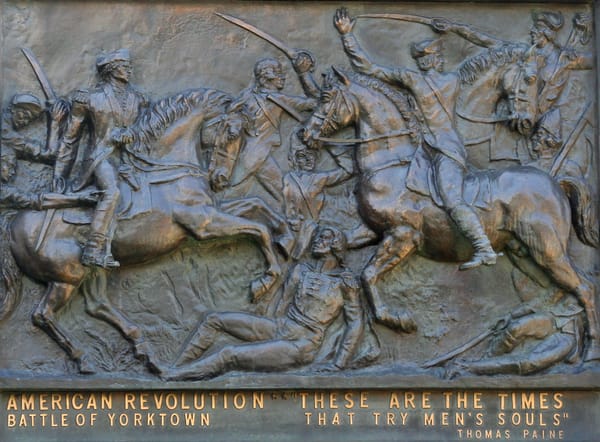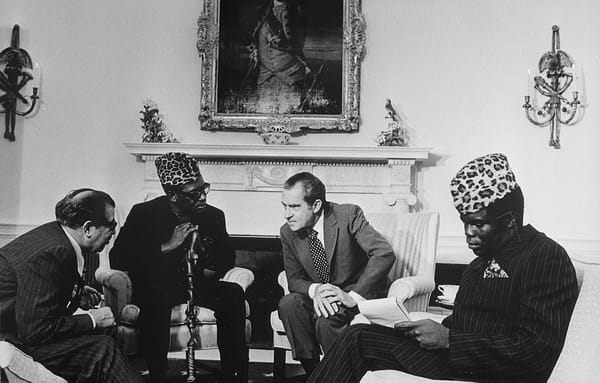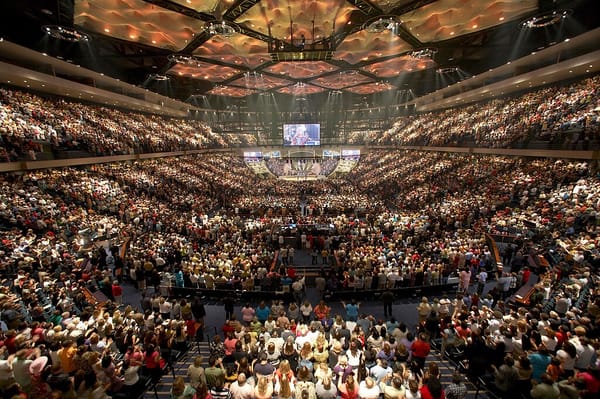Magic Kingdom Authoritarianism
Trump, Orbán, revival, and the superficial strongman.

Donald Trump feted Viktor Orbán earlier this month at Mar-a-Lago, his country club and Palm Beach dacha. We were treated to what we’ve come to expect from the strongman-loving former president, who has reserved special praise for Orbán’s seemingly permanent grip on Hungary’s courts, media, and electorate.
But I found the setting to be a natural inroad into a particular feature of MAGA politics, one that’s present across many Western far-right movements and that lends insight into the preferences of America’s hard right. Trump, the real estate man, has always fashioned himself an architecture and design aficionado. His private residences and signature development projects reflect a Baroque taste that no degree of ornamentation—especially in goldleaf—could put off.
Orbán, too, has shown a keen interest in the look and feel of his capital city’s built environment, and the potential for architecture and design to tell a particular political story. This is a common practice among autocratic rulers, but I am going to focus primarily on Trump and Orbán.
Disney World design: MAGA and Magyar revivalism
It’s true that Trump can’t help but splash every space he touches with golden hues and self-conscious totems of his wealth. But this shouldn’t be mistaken for the avant-garde. Gauche and overdone as Trump’s style is, it plays on a conservative, reactionary, instinct. His are the homes of royalty, a mishmash of Gilded Age American excess and a fever dream from the era of the divine right of kings. But it’s an imitation, a fabricated attempt to create the impression of a thing, and this is in part what I want to explore.
In office, the Trump administration pursued a strong sense of taste, imposing design standards for federal buildings that limited their design to “classical architecture.” In “An Executive Order on Promoting Beautiful Federal Civic Architecture,” the administration laid out its parameters:
Classical architecture’ means the architectural tradition derived from the forms, principles, and vocabulary of the architecture of Greek and Roman antiquity, and as later developed and expanded upon by such Renaissance architects as Alberti, Brunelleschi, Michelangelo, and Palladio; such Enlightenment masters as Robert Adam, John Soane, and Christopher Wren; such 19th-century architects as Benjamin Henry Latrobe, Robert Mills, and Thomas U. Walter; and such 20th-century practitioners as Julian Abele, Daniel Burnham, Charles F. McKim, John Russell Pope, Julia Morgan, and the firm of Delano and Aldrich. Classical architecture encompasses such styles as Neoclassical, Georgian, Federal, Greek Revival, Beaux-Arts, and Art Deco.
President Biden overturned Trump’s policies relating to government architecture and design, but last year House Republicans authored a bill that would have made “classical architecture” the standard for federal buildings in the District of Columbia and the “preferred” style everywhere else. Justin Shubow, who Trump appointed to the U.S. Commission on Fine Arts, told POLITICO’s Michael Schaffer that classical designs are essential to the character of American democracy:
They saw that classical architecture was timeless and time honored. And they wished to harken back to democratic Athens and republican Rome. They started a trend that continued for 150 years, and Americans came to associate classical architecture as the architecture of American democracy.
Orbán has engaged in a years-long project of renewal in the heart of Budapest. And he’s organized these projects around his own preferred view of Hungarian history, elevating the city’s classical architecture but also highlighting and obfuscating the narrative details as he sees fit.
Speaking to VICE News’ Matthew Cassel in 2022, Stephen Sholl, an American academic who decamped to Budapest for a fellowship at the government-backed Mathias Corvinus Collegium, explained:
For many people, appealing to the past builds a level of importance. It is reminding people that, you know, you come from a great line of people. What is a more visual depiction of your ideology, of your culture, of your society, than the architecture that you see?
But Sholl’s words ring hollow when we look beyond their facade. The real story of Budapest, told through its buildings, is one of intermingling cultures and collisions of imperial powers and the brimming diversity of Central Europe and the Balkans, the regions at whose crossroads Hungary sits. The city’s famous baths harken to its days under Ottoman rule, and the 19th and 20th century coffee houses for which Budapest remains famous are inextricably linked to that same Turkish legacy. It’s a far cry from the purified, Christian identity that Orbán seeks to impose on Hungary.
As Victor Sebestyen writes in his history of the city, Budapest: Between East and West:
In April, after the frosts have melted away, the graceful stone tomb is surrounded by the scent of violets. A month or so later come the roses of Rózsadomb, pink damascenas mainly, said to have been brought to Buda by Gül Baba. Whether that is true or not, the flowers and their scent, along with bath houses, paprika—and of course coffee—are the few remaining physical reminders of the 150-year-long occupation of Buda by the Turks.
Alongside its debts to the Muslim Ottomans, Budapest is also a center for Jewish heritage and design. The Dohány Street Synagogue, Europe’s largest, was the first to be built in the Moorish Revival style it helped to popularize. New York’s own Central Synagogue was heavily inspired by the Dohány Street Synagogue.
Orbán shelves the Ottoman and other multi-cultural elements of Hungarian history in favor of references to medieval Hungarian kings, the power of the post-1867 dual monarchy, and the World War Two-era regime of Miklós Horthy. Consider his government’s seizure and restoration of much of Budapest’s Castle District through what opponents have called “an arbitrary, dictatorial decision” or the Monument of National Martyrs, a recreation of a Horthy-era monument with an Orbánist twist of revisionism that absolves Hungary of any fault during the Holocaust.
Consider a more modern example: the daring, inventive site of what had been the main home of one of the greatest symbols of Hungary’s post-Soviet potential, the Central European University.
In this case, the building itself tells a tragic story. The product of ambitious growth and a vision for providing a world-class education center in one of the great cities of Europe, the not even ten-year-old center is not the locus of intellectual activity many hoped it would be. The university has now largely decamped to Vienna, leaving what had been its home in the heart of Budapest a mere satellite campus—another casualty in Orbán’s war on liberalism and his feud with one of its founding donors, George Soros.
So a common theme here is the way the past is being evoked, even rebuilt, in a striking but sanitized fashion. The street-front effect of Orbán’s building projects can be remarkable. But so, too, is walking the perfectly designed byways of Disney’s Magic Kingdom. Neither the city hall nor the castle are authentic in the sense of being the actual thing they evoke. They exist to produce a feeling, as a mixture of transportive nostalgia and magical wonder. In a place like Disney World, this is a delightful experience, but in Trump’s America and Orbán’s Hungary the goal is more than mere fantasy. It’s to assert a lie.
MAGA culture critics talk about extolling America’s civic heritage. Yet Trump has done nothing but obliterate America’s democratic norms, mocking the memory of the country’s greatest advocates for liberty and equality and draping its institutions in the gaudy decor of his authoritarian narcissism. Despite his claims that Biden will destroy the country, it’s Trump and Trumpism that threaten to snuff out our republic on the eve of its 250th birthday. His own homes and towers betray what has almost always been true of the debt-ridden, self-proclaimed billionaire who just announced he is unable to pay the half-billion-dollar bond from his civil fraud trial: his entire image is a myth and a poisonous one at that.
Both men seek to imprint a fiction through the built environment. In reality, they impose themselves and their sordid ideologies on the spaces that they have curated, from Mar-a-Lago to Martyr’s Square.
The architecture of oppression
Speaking with Chris Cuomo earlier this month, Tucker Carlson praised the architecture he encountered on his recent trip to Moscow:
“[The] public spaces are beautiful. The architecture has not been degraded by the oppression of post-modern architecture, which is designed to demoralize and hurt you–to destroy your spirit.” When Cuomo questioned this assertion, Carlson argued, “Buildings that are warm and human and that elevate the human spirit are pro-human. And Brutalism, for example, or the I.M. Pei glass boxes that crowd every city in the United States, those are not elevating.”
This is a common right-wing talking point and meme. A slew of X (née Twitter) accounts with statue avatars post a daily stream of images from Ancient Rome to renaissance Europe to 19th and early 20th century America with a “this is what they took from us” undertone. Unsurprisingly, The Culture Critic—one of the most prolific of these accounts, with a follower count over a million—posted a long thread agreeing with Carlson’s assessment of Brutalist and other post-war architectural styles and bemoaning their rise in the American urban landscape. Juxtaposing Art Deco and neo-Gothic skyscrapers with glass-and-steel ones, he wrote “And if your goal was to demoralize, this is exactly what you would do…”
There is, as the account for The Paul Rudolph Institute for Modern Architecture commented, no real grasp on the principles or histories of the styles being criticized here. But that’s not the point. The point is to strike the same apocalyptic culture war tone as they do in art, literature, and the rest of American public life.
The goal is to create bogeymen of degradation and oppression out of anything that can be called contemporary (modern and post-modern are both thrown about in confusing fashion) because then the past can be offered as an escape. It’s fitting that the same Culture Critic thread specifically decried the fact that churches have been built in the Brutalist style, a building phenomenon that critics and observers have noted sought to modernize Christianity amidst a secularizing Europe—one where so many pews now sit empty.
Of course architecture is often used as a tool for coercion and propaganda, and there were ways in which places like fascist Italy and Germany were bound up in contemporary ideas of the modern in their approach to design. At the same time, the styles associated with the classical past—or, more specifically, the periods associated with greatness in their own national histories—have been used by rulers to express the strength and values of their ultimately dystopian societies.
The Americans like Sholl who have flocked to Budapest in search of more illiberal climes fawn over Orbán’s Magyar revivalism precisely because they agree with its propagandist intentions. They see in the Orbánist program a map for their own desire to force a conservative vision of America on the country, and many have been quite open about this. Gladden Pappin, another American academic who is now the president of the Orbán-backed Hungarian Institute of International Affairs, has said that today’s conservatives in America don’t have “a serious approach to wielding political power.” For Pappin, Hungary is a model. As he told VICE’s Matthew Cassel in the same report that featured Sholl, “[Orbán] is controversial because he rejects the liberalism part of liberal democracy. As an anti-liberal, I think that’s good…We should pass into the U.S. Constitution anything that is fundamentally required to protect the things that have been taken away by other forms of legislation or by the Supreme Court.”
In America, it’s true that many of the Founding Fathers, including Jefferson, valued the principles of Greek and Roman architecture, including for its democratic and republican features. But it’s also true that Trump has never qualified his admiration for America’s early leaders like Jefferson and Jackson with any substantive rejection of the institutions of racism and chattel slavery that shaped the young nation. In fact, his embrace of them has always seemed to include these (to many, fatal) flaws. And the neo-classical architecture so beloved by MAGA enthusiasts was also the style of choice for antebellum Southern plantation owners. Historians have noted the Southern elite’s affection for Aristotelian thought and the supposedly ancient virtues of an aristocratic, slave-owning society.
Retrofitting the nation
Art and architecture do have the capacity to liberate us—to inspire and to welcome, as well as to break boundaries and old ideas about the limitations of who we are and the sort of societies we want to live in.
So when people like Tucker Carlson talk about buildings being “human” or leaders like Viktor Orbán engage in ambitious renewal projects, they are speaking to a vital aspect of how we as people interact with the built environment. But they also approach this in profane and vulgar ways, malforming history and constraining the human spirit to fit sanitized and superficial definitions of beauty and culture.
Featured image is The Brutalism of Austin, by Daniel X. O'Neil




